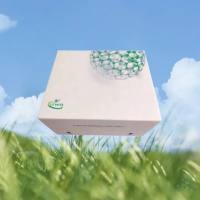Quantitative Fluorescence In Situ Hybridization (QFISH) of Telomere Lengths in Tissue and Cells
互联网
- Abstract
- Table of Contents
- Materials
- Figures
- Literature Cited
Abstract
Telomeres are repetitive DNA sequences at the end of each chromosome that provide stability and prevent end?to?end chromosome fusions. In order to understand mechanisms responsible for telomere shortening, it is necessary to develop methods for accurate telomere length measurement that can be applied to archival and fresh tissue and cells. This unit describes in situ?based quantitative fluorescence in situ hybridization (QFISH) protocols using a fluorescence?conjugated telomere probe (peptide nucleic acid, PNA) that stains telomeres proportionally to their length. These protocols can be used on formalin?fixed paraffin?embedded tissue, lightly fixed tissue, cells isolated from tissue, cultured cells, and agar?embedded cells. The basic protocol for QFISH staining is modified to achieve excellent QFISH staining for a variety of cell preparations. Image?analysis techniques to quantitate average telomere lengths from tissues and isolated stained cells are also described.
Keywords: telomere length; quantitative fluorescence in situ hybridization (QFISH); tissue sections; cultured cells; fixation protocols
Table of Contents
- Basic Protocol 1: Preparation of Lightly Fixed Tissue for QFISH
- Alternate Protocol 1: Preparation of Frozen Sections for QFISH
- Basic Protocol 2: Basic QFISH Staining Procedure
- Alternate Protocol 2: Modified QFISH for Formalin‐Fixed Archival Tissue
- Alternate Protocol 3: Preparation of Cultured Cells for QFISH
- Alternate Protocol 4: Preparation of Cell Pellets Embedded in Paraffin Post‐Culture for QFISH
- Alternate Protocol 5: Preparation of Epithelial Cells Isolated from Tissue Biopsies for QFISH
- Basic Protocol 3: Image Analysis to Quantitate Average Telomere Length
- Reagents and Solutions
- Commentary
- Literature Cited
- Figures
Materials
Basic Protocol 1: Preparation of Lightly Fixed Tissue for QFISH
Materials
Alternate Protocol 1: Preparation of Frozen Sections for QFISH
Materials
Basic Protocol 2: Basic QFISH Staining Procedure
Alternate Protocol 2: Modified QFISH for Formalin‐Fixed Archival Tissue
Alternate Protocol 3: Preparation of Cultured Cells for QFISH
Alternate Protocol 4: Preparation of Cell Pellets Embedded in Paraffin Post‐Culture for QFISH
|
Figures
-
Figure 12.6.1 (A ) FISH analysis of a peripheral blood metaphase spread. Telomeres are labeled with a FITC‐conjugated PNA probe (green), centromeres with a TAMRA probe (red), and DNA with a TOTO‐3 DNA dye (false‐colored blue). Prometaphase and interphase cells are also shown in this image. (B ) Confocal QFISH image of a normal colon biopsy. (C ) Biopsy of a patient with ulcerative colitis. (D ) A large colon adenoma. Telomere and centromere staining intensities are equal for epithelial and stroma cells in panel B. Reduced telomere (green) fluorescence is evident in the epithelial cells of the ulcerative colitis and large‐colon adenoma cases (C and D) compared to the stromal‐cell telomere staining in the same section. The average intensity of the centromere and DNA staining remained unchanged between epithelial and stroma cells. The centromere and DNA probes therefore serve as internal controls for changes in telomere brightness that might have resulted from reduced accessibility to the telomere probe. View Image -
Figure 12.6.2 Illustration of the three image‐analysis algorithms described in the text: (A ) background‐corrected fluorescence; (B ) spot‐finding method; (C ) background‐curve subtraction. View Image
Videos
Literature Cited
| Literature Cited | |
| Allshire, R.C., Dempster, M., and Hastie, N.D. 1989. Human telomeres contain at least three types of G‐rich repeat distrbuted non‐randomly. Nucleic Acids Res. 17:4611‐4627. | |
| Blackburn, E.H. 1991. Structure and function of telomeres. Nature 350:569‐572. | |
| Brown, W.R., MacKinnon, P.J., Villasante, A., Spurr, N., Buckle, V.J., and Dobson, M.J. 1990. Structure and polymorphism of human telomere‐associated DNA. Cell 63:119‐132. | |
| Dean, P.N. 1980. A simplified method of DNA distribution analysis. Cell Tissue Kinet. 13:299‐308. | |
| Meeker, A.K., Hicks, J.L., Platz, E.A., March, G.E., Bennett, C.J., Delannoy, M.J., and De Marzo, A.M. 2002a. Telomere shortening is an early somatic DNA alteration in human prostate tumorigenesis. Cancer Res. 62:6405‐6409. | |
| Meeker, A.K., Gage, W.R., Hicks, J.L., Simon, I., Coffman, J.R., Platz, E.A., March, G.E., and De Marzo, A.M. 2002b. Telomere length assessment in human archival tissues: Combined telomere fluorescence in situ hybridization and immunostaining. Am. J. Pathol. 160:1259‐1268. | |
| Oexle, K. 1998. Telomere length distribution and Southern blot analysis. J. Theor. Biol. 190:369‐377. | |
| O'Sullivan, J.N., Bronner, M.P., Brentnall, T.A., Finley, J.C., Shen, W.T., Emerson, S., Emond, M.J., Gollahon, K.A., Moskovitz, A.H., Crispin, D.A., Potter, J.D., and Rabinovitch, P.S. 2002. Chromosomal instability in ulcerative colitis is related to telomere shortening. Nat. Genet. 32:280‐284. | |
| O'Sullivan, J.N., Finley, J.C., Risques, R.A., Shen, W.T., Gollahon, K.A., Moskovitz, A.H., Gryaznov, S., Harley, C.B., and Rabinovitch, P.S. 2004. Telomere length assessment in tissue sections by quantitative FISH: Image analysis algorithms. Cytometry 58A:120‐131. | |
| Poon, S.S., Martens, U.M., Ward, R.K., and Lansdorp, P.M. 1999. Telomere length measurements using digital fluorescence microscopy. Cytometry 36:267‐278. | |
| Rudolph, K.L., Millard, M., Bosenberg, M.W., and DePinho, R.A. 2001. Telomere dysfunction and evolution of intestinal carcinoma in mice and humans. Nat. Genet. 28:155‐159. | |
| Rufer, N., Dragowska, W., Thornbury, G., Roosnek, E., and Lansdorp, P.M. 1998. Telomere length dynamics in human lymphocyte subpopulations measured by flow cytometry. Nat. Biotechnol. 16:743‐747. | |
| van Heek, N.T., Meeker, A.K., Kern, S.E., Yeo, C.J., Lillemoe, K.D., Cameron, J.L., Offerhaus, G.J., Hicks, J.L., Wilentz, R.E., Goggins, M.G., De Marzo, A.M., Hruban, R.H., and Maitra, A. 2002. Telomere shortening is nearly universal in pancreatic intraepithelial neoplasia. Am. J. Pathol. 161:1541‐1547. | |
| Zeller, R. 1989. Fixation, embedding, and sectioning of tissues, embryos, and single cells. In Current Protocols in Molecular Biology (F.M. Ausubel, R. Brent, R.E. Kingston, D.D. Moore, J.G. Seidman, J.A. Smith, and K. Struhl, eds.) pp. 14.1.1‐14.1.8. John Wiley & Sons, Hoboken, N.J. |









